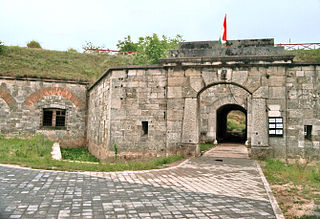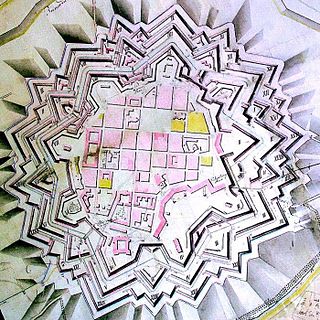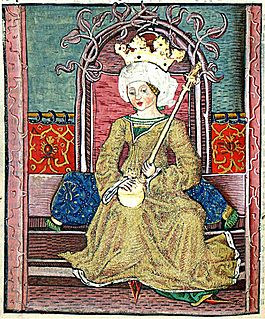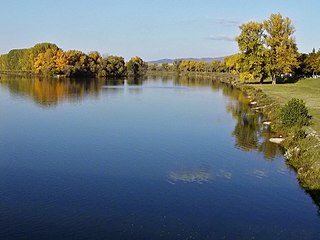
Emeric Thököly de Késmárk was prince of Upper Hungary from 1682 to 1685, and prince of Transylvania in 1690. His father, Count István Thököly, held large domains in Royal Hungary. Emeric's mother, Mária Gyulaffy, was related to three princes of Transylvania. He was a child when he inherited his mother's estates in Transylania proper and the domains of his uncle, Count Francis Rhédey, Prince of Transylvania, in Máramaros County. István Thököly was involved in the leading aristocrats' conspiracy against the Habsburg monarch, Leopold I, and died fighting against the royal troops in late 1670. Emeric fled to the Principality of Transylvania and his estates in Royal Hungary were confiscated.

Komárom is a city in Hungary on the south bank of the Danube in Komárom-Esztergom county. Komárno, Slovakia, is on the northern bank. Komárom was formerly a separate village called Újszőny. In 1892 Komárom and Újszőny were connected with an iron bridge and in 1896 the two towns were united under the name city of Komárom. The fortress played an important role in the Hungarian Revolution of 1848 and many contemporary English sources refer to it as the Fortress of Comorn

The Battle of Saint Gotthard was fought on August 1, 1664 as part of the Austro-Turkish War (1663–1664), between the Imperial Army led by Generalleutnant Raimondo Montecuccoli, Jean de Coligny-Saligny, Wolfgang Julius, Count of Hohenlohe-Neuenstein, together with the Army of the Holy Roman Empire led by Reichsgeneralfeldmarschall Prince Leopold of Baden and Reichsgeneralfeldmarschalleutnant Georg Friedrich of Waldeck and the army of the Ottoman Empire under the command of Köprülü Fazıl Ahmed Paşa.
The Battle of Petrovaradin or Peterwardein was a decisive victory for the Imperial Army of the Holy Roman Emperor in the war between the Archduchy of Austria of the Holy Roman Empire and the Ottoman Empire (1716–1718), at Petrovaradin.

The Long Turkish War or Thirteen Years' War was an indecisive land war between the Habsburg Monarchy and the Ottoman Empire, primarily over the Principalities of Wallachia, Transylvania and Moldavia. It was waged from 1593 to 1606 but in Europe it is sometimes called the Fifteen Years War, reckoning from the 1591–92 Turkish campaign that captured Bihać.

The Siege of Eger occurred during the 16th century Ottoman Wars in Europe. In 1552 the forces of the Ottoman Empire led by Kara Ahmed Pasha laid siege to the Castle of Eger, located in the northern part of the Kingdom of Hungary, but the defenders led by István Dobó repelled the attacks and defended the castle. The siege has become an emblem of national defense and patriotic heroism in Hungary.

Rákóczi's War of Independence (1703–11) was the first significant attempt to topple the rule of the Habsburgs over Hungary. The war was fought by a group of noblemen, wealthy and high-ranking progressives and was led by Francis II Rákóczi. The insurrection was unsuccessful, closed by Treaty of Szatmár, however the Hungarian nobility managed to partially satisfy Hungarian interests.

The Austro-Turkish War (1663–1664) or fourth Austro-Turkish War was a short war between the Habsburg Monarchy and the Ottoman Empire. The Ottoman aim was to resume the advance in central Europe, conquer Vienna and subdue Austria. However, the Habsburg army under Raimondo Montecuccoli succeeded in halting the Ottoman army on its way to Vienna in the Battle of Saint Gotthard and destroy it, while another Austrian army won another victory at Léva. Despite these serious Ottoman defeats, the war ended for them with the rather favourable Peace of Vasvár.

Battle of Zsibó was fought on November 15, 1705 between the Kuruc (Hungarian) army and forces of the Habsburg Empire, Kingdom of Denmark and Vojvodian Serbs in Zsibó, Principality of Transylvania. The Austrian marshal Ludwig Herbeville marched against Transylvania. Although the Kuruc-French army was equal in size to the combined Austrian, Danish and Serbian forces, Francis II Rákóczi went on the defense due to the inferior training of his troops. The Danes and Austrians launched a powerful attack on the French and Kuruc infantry. Although the Kuruc infantry held its ground, the Kuruc cavalry could not launch an attack due to a lack of leadership and an overly muddy battlefield. The Austrian cavalry was thus capable of flanking the Hungarians on the left, forcing the Hungarians to retreat and crushing their cavalry in the process. After the battle, the combined Austrian-Danish army bought Transylvania.
The Battle of Biskupice was a battle between the Kurucs (Hungarians) and the Danish auxiliaries of the Habsburg army in April 21, 1704.

The First battle of Komárom was one of the most important battles of the Hungarian War of Independence, fought on 26 April 1849, between the Hungarian and the Austrian Imperial main armies, which some consider ended as a Hungarian victory, while others say that actually it was undecided. This battle was part of the Hungarian Spring Campaign. After the revolutionary army attacked and broke the Austrian siege of the fortress, the Imperials, having received reinforcements which made them numerically very superior to their enemies, successfully counterattacked, but after stabilising their situation, they retreated towards Győr,leaving the trenches and much of their siege artillery in Hungarian hands. By this battle the Hungarian revolutionary army relieved the fortress of Komárom from a very long imperial siege, and forced the enemy to retreat to the westernmost margin of the Kingdom of Hungary. After this battle, following a long debate among the Hungarian military and political leaders about whether to continue their advance towards Vienna, the Habsburg capital, or towards the Hungarian capital, Buda, whose fortress was still held by the Austrians, the second option was chosen.
Paul from the kindred Szécs, also known as Paul of Komárom was a Hungarian nobleman and landowner, who was lord of Komárom since the 1280s. He came to prominence during the last regnal years of Andrew III of Hungary.

Timișoara Fortress is a historical fortress in western Romania around which the town of Timișoara was built.
Andrew Kőszegi was a Hungarian lord in the early 14th century, who was a member of the powerful Kőszegi family. His failed rebellion against Charles I of Hungary in 1317 contributed to the gradual collapse of the family's rule in Transdanubia.


























